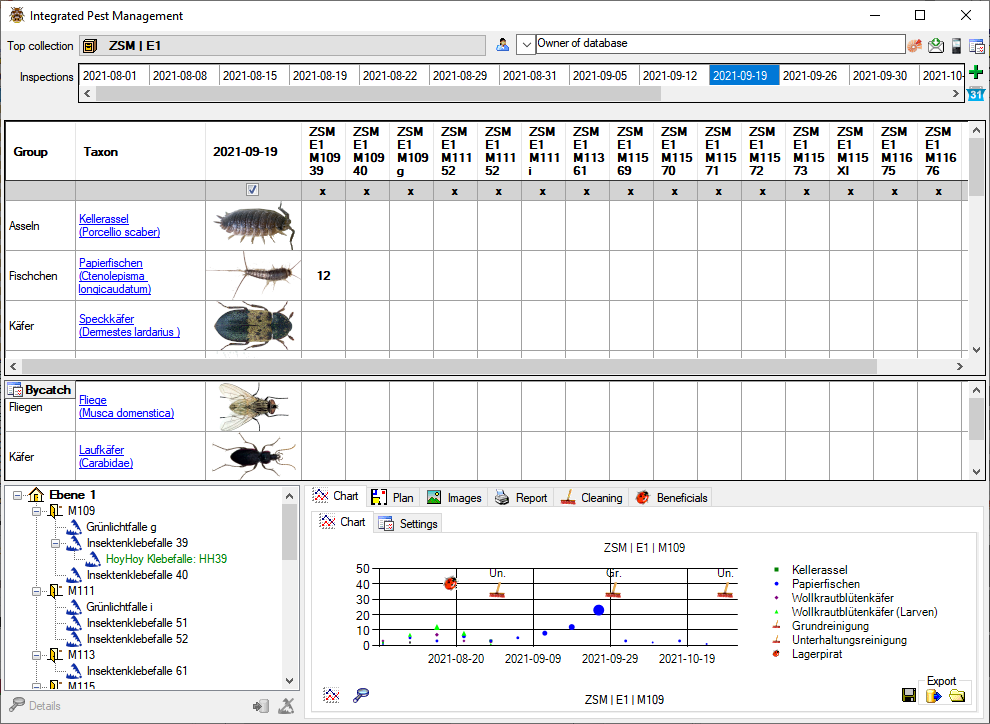IPM
The DiversityWorkbench provides several applications addressing every IPM related task:
- Taxonomy of IPM related taxa
- Identification key for pests
- Collecting sensor data
- Editing, collecting, exporting data in a desktop application.
- A web application for trap inspection (ongoing project)
IPM taxonomic names
Taxonomic backbone providing 3 lists of taxa related to IPM:
- Pests
- Bycatch
- Beneficials
The data include the taxonomic hierarchy, synonoyms, common names, life stages, links to information and thumbnails of the taxa for inclusion in e.g. tabular lists used for monitoring. Data are provided via a JSON API. For details see IPM
IPMobile
(ongoing project)
Mobile application for collecting taxon observations in traps etc. You can import existing data to ensure continuity and build upon historical information. Data are stored in a local SQLite database and synchronized via an API with the main database to enable offline inspection of the traps, specimen etc.
Zwischengespeicherte Daten für offline Betrieb
- Taxonliste incl. Vorschaubildern
- Bilder von Fallen
- Grundriss
Zugriffsarten
es können alte Daten eingelesen und neue Daten geschrieben werden. Ändern und Löschen nach dem Speichern ist nicht vorgesehen.
- Lesen
- Taxonliste
- Grundrisse
- Bar- und QR-Codes
- Schreiben
- Beobachtungen von Schädlingen (Art, Anzahl, Ort)
- Eingeben von Anmerkungen
- Ändern
- Löschen
Einstellungen
Auswahl der Taxa die für die Erfassung berücksichtigt werden sollen
Bereiche
- Fallen
- Specimen
- Sensoren
Funktionen
- Verortung in Plänen
- Bilder von Fallen etc.
- Zuordnung von Detailbildern zu Übersichtsaufnahme und deren Verortung innerhalb der Übersichtsaufnahme
- Scannen von Codes auf Objekten und automatisches Laden der zugehörigen Daten
- Eintrag von Notizen
Szenarien
- Der User will einen Schädling eintragen können den er gerade auf einem Specimen gefunden hat.
- Der User will eintragen, dass er keinen Schädling gefunden hat auf einem Specimen, Falle, Raum, Sammlung, …
- Der User hat eine Falle aufgestellt und möchte die Falle anhand des QR-Codes auf der Falle identifizieren und die Position der Falle im Plan vermerken sowie evtl. eine Beschreibung des Standorts eingeben.
- Der User möchte alle Fallen anhand eines Plans der Aktuellen Etage abgehen und dabei prüfen ob in den Fallen Fänge sind.
- Der User möchte den aktuellen Zustand der Falle anhand von Bildern mit vorherigen Zuständen vergleichen
- Der User hat einen Schaden entdeckt und möchte das Objekt anhand des Codes identifizieren sowie den Schaden mit einem Bild dokumentieren und einen kurzen Text schreiben was genau kaputt ist.
- Über Bestimmungsapp via DD
- Der User will dem gefunden Schädling einen Namen zuweisen
Tabellen in SQLite
-
lesend
- Collection
- CollectionSpecimen
- CollectionSpecimenPart
- IdentificationUnit
- Task
- CollectionTask_old (oder Marker in Tabelle CollectionTask)
- CollectionTaskImage_old (oder Marker in Tabelle CollectionTaskImage)
-
schreibend
- CollectionTask
- CollectionTaskImage
IPM sensors
Sensors collecting room temperature and moisture values communicate via Bluetooth LE with IPMhubs. IPMhubs communicate with IPMserver via LoRa IPMserver collects sensor data provided by the IPMhubs and stores these data in a Prometheus timeseries database. These data are then provided for import in the main database via LAN.
IPMcollection
- Spatial: The software provides the option to include floor plans and accurately pinpoint the locations of sensors and traps including the hight within a room. To avoid interference with administrative aspects of a collection, the software includes the option for a second hierarchy according to the positions.
- Recording: Next to sensor data all events, observations etc. can be recorded for later evaluation aiming at the prediction of the effect of IPM related actions.
- Customization: You can define templates or create custom task definitions based on your specific IPM requirements. This includes e.g. the typification of traps and treatments. The list of taxa based on the backbone can be adapted based on those taxa that should be included in the recoding.
- Reports: Generation of reports including charts, floorplans, treatments etc.
- Actions: Documenation of IPM related treatments of collection specimen, application of beneficial organisms etc.

